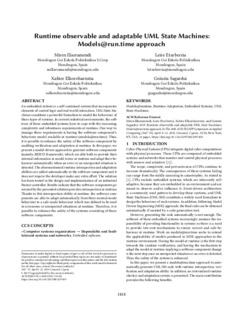Izenburua
Runtime observable and adaptable UML state machines: models@run.time approachArgitalpen data
2019Bertsioa
Bertsio argitaratuaDokumentu-mota
Kongresu-ekarpenaKongresu-ekarpenaHizkuntza
IngelesaEskubideak
© The AuthorsSarbidea
Sarbide irekiaArgitaratzailearen bertsioa
http://dx.doi.org/10.1145/3297280.3297459Non argitaratua
Proceeding SAC '19: Proceedings of the 34th ACM/SIGAPP Symposium on Applied Computing. Limassol, Cyprus. April 8-12. Pp. 1818-1827. New York: ACM, 2019Argitaratzailea
ACMGako-hitzak
Models@runtimeRuntime Adaptation
Embedded Systems
UMLState Machines
Laburpena
n embedded system is a self-contained system that incorporateselements of control logic and real-world interaction. UML State Ma-chines constitute a powerful formalism to model the behaviour ofthese t ... [+]
n embedded system is a self-contained system that incorporateselements of control logic and real-world interaction. UML State Ma-chines constitute a powerful formalism to model the behaviour ofthese types of systems. In current industrial environments, the soft-ware of these embedded systems have to cope with the increasingcomplexity and robustness requirements at runtime. One way tomanage these requirements is having the software component’sbehaviour model available at runtime (models@run.time). Thus,it is possible to enhance the safety of the software component byenabling verification and adaptation at runtime. In this paper, wepresent a model-driven approach to generate software components(namely, RESCO framework), which are able both to provide theirinternal information in model terms at runtime and adapt their be-haviour automatically when an error or an unexpected situation isdetected. The aforementioned runtime introspection and adaptationabilities are added automatically to the software component and itdoes not require the developer make any extra effort. The solutionhas been tested in the design and implementation of an industrialBurner controller. Results indicate that the software components ge-nerated by the presented solution provides introspection at runtime.Thanks to this introspection ability at runtime, the software com-ponents are able to adapt automatically from their normal-modebehaviour to a safe-mode behaviour which was defined to be usedin erroneous or unexpected situations at runtime. Therefore, it ispossible to enhance the safety of the systems consisting of thesesoftware components. [-]





















